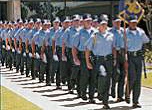 The present California Highway Patrol Academy is one of the most modern and complete law enforcement training academies in the United States. The Academy will accommodate 280 students in dormitory rooms designed for up to two persons per room. There are four rooms to a cluster, and these rooms share a common restroom.
The present California Highway Patrol Academy is one of the most modern and complete law enforcement training academies in the United States. The Academy will accommodate 280 students in dormitory rooms designed for up to two persons per room. There are four rooms to a cluster, and these rooms share a common restroom.
The dining facility is designed to seat 400 persons. Food is served cafeteria-style, three times daily.
The multipurpose room serves as a gymnasium as well as an auditorium for graduation ceremonies. The gymnasium is complete with a full basketball court, exercise machines, weight training equipment, and a whirlpool bath. Other physical training facilities consist of a quarter-mile running track, a 442-foot long obstacle course, 2.3- and 3.6-mile jogging trails, and a baseball field.
A large water safety tank is used to teach water safety and underwater vehicle extraction rescue training. An underwater viewing room allows students and instructors to observe rescue techniques as they are performed.
